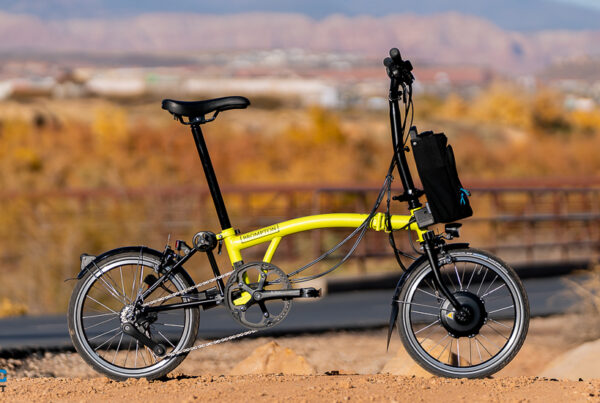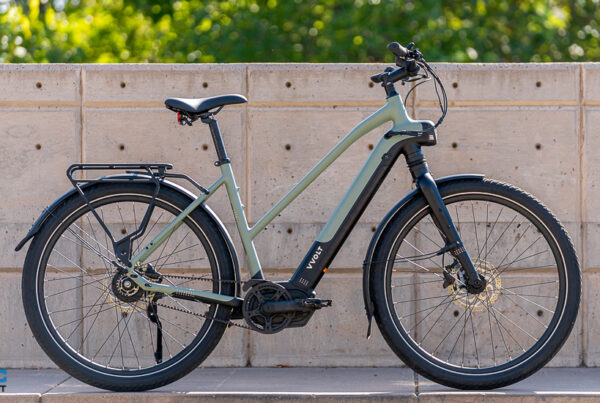The first test we perform with any e-bike is our Circuit Test, explained in the graphic above. This allows us to get acquainted with each model and learn its feel, adapt to its handling, and grasp the relationship between its power levels.
With its Dapu 500W mid-drive motor, the Galaxy Lux rides similarly to a traditional bicycle. Its torque sensors adjust the amount of input from the motor based on the amount of effort the rider applies. As opposed to some e-bikes with rear hub motors that do most of the work, this means that it can still take some exertion to propel the Lux, but the difficulty is managed both by the PAS system and the Enviolo Automatiq shifting system.
I said it previously in my other recent Evelo e-bike review of the Galaxy SL and I’ll say it again here: by looks alone, I did not expect the Galaxy Lux to be a speedy e-bike, but it surprised me with its capability in higher pedal assist settings. The Circuit Test graph above shows a similar pattern to that of the SL, in that the Lux’s pedal assist system (PAS) delivers a relatively linear increase in power between levels. We really like to see this sort of tuning, as it ensures that A) the rider notices a difference between levels; and B) the jumps feel intuitive and predictable.
When comparing the Lux to its twin, I really felt a difference in the motor’s input. The two e-bikes have the same motor and showed similar data points in our testing, but due to its 48V battery (as opposed to the SL’s 36V power source), the Lux felt more responsive and powerful, with quicker acceleration. Responsive is the key word here; the bike never felt like it was too powerful, it just felt right.
Let’s dive a little further into the functionality and behavior of the Enviolo Automatiq shift system, as it interacts interestingly with the Lux’s PAS. The shifter presents as a small control pad on the right handlebar. Once activated, it allows the user to set a baseline level of resistance, which coincides to a cadence setting based on revolutions per minute (RPMs) of the cranks. With a higher cadence, or faster RPMs, less effort is required (similar to a high gear on a standard cassette). With a lower cadence, or fewer turns per minute, the effort increases. The system pairs with an app for calibration purposes, and also displays a numbered cadence/RPM setting, which is not otherwise displayed on the bike’s control pad. This can be a little confusing when looking at both a screen and a control pad (the up button on the pad decreases cadence which increases difficulty), but it feels intuitive with just one or the other.
As the rider pedals along, the Lux’s automatic shifting system detects natural changes in cadence and rotation and adjusts accordingly, though it does have a slight lag in its response time. I appreciated its effectiveness when going uphill, but sometimes found myself pedaling a little too freely for a second or two on the other side of the hill before it caught up. The union of the Automatiq system and the PAS seemed appropriate though, making lower PAS settings feel more effective on hills than I expected despite offering limited input from the motor. Due to the increase in motor assistance in higher PAS settings, I found myself also increasing that baseline resistance level from the shift system to maintain a consistent level of input while maximizing my overall speed.
If I have any real critique with the feel of the Automatiq system, it’s that the adjustment of the shifter’s baseline setting feels a bit too granular. It adjusts by single-RPM increments, which means that it takes many presses of the button (or a longer but less accurate hold) to feel any real difference. While I understand that a high degree of customization is a feature with the CVT, I’d personally prefer to see increments of 5 RPMs at a time instead of 1, which might provide more immediately noticeable differences. Also, considering that the system is made by Enviolo and not Evelo, this critique isn’t really pointed toward the Galaxy Lux itself.
One area I do have to give the Lux recognition for is the inclusion of the Gates belt drive. I’ve mentioned that this system is low-maintenance, but it has an added benefit. When looking at other e-bikes with mid-drive motors and chain-driven gearing systems, we have often seen a surprising level of wear and tear on cassettes caused by the motors’ increased torque. This is most common on low-end cassettes, but the potential still exists for greater wear in any setup using a chain. The belt drive on the Lux completely removes this possibility, and we’d love to see it included with more mid-drive motors.
Overall, I think the Lux’s motor, CVT, and automatic shifter worked remarkably well together. They are a solid combination for someone who doesn’t want to think much about shifting when they hop on a bike, but who still desires a responsive machine with power that is available when it is needed.
Source link








